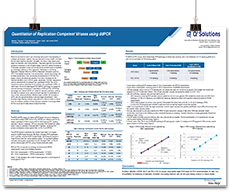
Quantitation of Replication Competent Viruses using ddPCR
Retroviral and lentiviral vectors are increasingly being used in the engineering of oncologic cell therapies; however, they may pose risk to human health in the event the viral vector becomes replication competent. As a result, these vectors could target non-neoplastic cells during treatment. Regulatory agencies have provided guidance to developers of cell and gene therapy products for testing the presence of replication competent viruses such as retroviruses and lentiviruses during follow up monitoring of patients on these treatments. Approaches to monitoring Replication Competent Retrovirus (RCR) or Replication Competent Lentivirus (RCL) have targeted sequences to structural proteins, reverse transcriptase, and envelope glycoproteins. Here, we describe the performance of RCR and RCL assays, carrying the Gibbon-ape leukemia virus (GALV) envelope and the Vesicular stomatitis virus G (VSV-G) genes, respectively. The GALV sequence is used as a biomarker for the presence and quantitation of RCR. The VSV-G sequence is used as a biomarker for the presence and quantification of RCL. In recent years, the use of droplet digital PCR (ddPCR) technology has allowed for improved accuracy and precision in quantitation of RCR and RCL. ddPCR has advantages over standard qPCR, as it allows for absolute quantitation, avoiding the need for a standard curve, uses an end-point approach to quantification of copy number, hence amplification efficiency plays a smaller role compared to qPCR, and has high reproducibility at low input target concentrations. With hundreds of gene therapy products using retroviral or lentiviral vectors in clinical trials, the analytical validation of these replication competent virus assays allows for their use as part of safety studies during clinical trials.
Complete the form below to access this scientific poster and explore the methods, results, and conclusions of this study.








